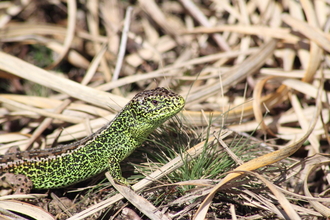Spotted a snake?
There are three species of snake native to the UK: grass snake, adder and smooth snake. Depending on where you are will affect what type of snake you're more likely to see.
Adder
The adder is a greyish snake, with a dark and very distinct zig-zag pattern down its back, and a red eye. Males tend to be more silvery-grey in colour, while females are more light or reddish-brown. Black (melanistic) forms are sometimes spotted. Adders are small, around 60 to 80cm and are mostly likely to be spotted in woodland, heathland and moorland habitat. Read more
Grass snake
The grass snake is usually greenish in colour - although this can vary. They have a yellow and black collar, pale belly, and dark markings down the sides. They are our longest snake and can grow up to 150 cm. They are usually spotted in wetlands and grasslands but can be seen in gardens too. They can be attracted to compost heaps where they sometimes lay their eggs. Read more
Smooth snake
Similar in appearance to the adder, the smooth snake can be distinguished by its more slender body, round pupil and less well-formed dark pattern on its back. It is usually grey or dark brown in colour and around 60-70 cm in length. The rare smooth snake can only be found at a few heathland sites in the UK. Read more
Not a snake!
Slow worm
At first glance, the slow worm might be mistaken for a snake, but it's actually a legless lizard! The slow worm is much smaller than a snake, with smoother, golden-grey skin. The head is a similar width to the body and seems to flow seamlessly into it, whereas our snakes have a slightly broader head that looks more distinct from the body. On closer inspection, slow worms also have eyelids and can be seen blinking (snakes do not), and they can shed their tail if threatened.
















